Effects of Time to Unactuate Air Conditioning on Fire Growth
Abstract
:1. Introduction
2. Literature Review
2.1. The Air Conditioning Design
2.2. The Influence of Ventilation Changes on Fire Growth
3. Numerical Investigation
3.1. Setting of Grid Parameters
3.2. Description of Fire Scenario
- The initial room temperature and the inlet air temperature of an FCU system were 25 °C;
- According to the Air Conditioning System Management and Energy Saving Manual [14], the unit air volume of the FCU system for the room dimension was 400 CFM (cubic feet per minute), equivalent to 680 CMH (cubic meters per hour). The air supply was set as 0.5 m/s;
- The actions of the air inlet were set as “turn on an FCU” and “turn off an FCU”, the status of the door was set as opened or closed;
- Morgan [37] recommends an HRR per unit area of 225 kW/m2 for offices with air conditioning systems. This investigation had a room floor area of approximately 14.4 m2 and thus set a free-burning wood to reach about 2 MW in open space. The size of the initial ignition was 0.1 m (L) × 0.1 m (W). Figure 3 presents the arrangement of the wood pile. The wood sticks were divided into 0.9 m (L) × 0.1 m (W) × 0.1 m (H) and 0.7 m (L) × 0.1 m (W) × 0.1 m (H) and overlap each other. The HRR per unit area of wood was 4500 kW/m2. Related material information of wood was from Drysdale [38], and related combustion reaction data were from Tewarson [39]. The fire source was set in the center (most common fire scenario) or corner (worst fire scenario) of the room;
- A stack of wood fire occurred within 900 s of simulation time (s);
- The version of FDS used in this study was FDS 6.0.1.
4. Results and Discussion
4.1. Influence of Air Inlet Actions of an FCU with an Opened Door
4.1.1. Fire Source in the Room Center
- VSL denotes the volume of smoke layer,
- VS is the volume of smoke generated,
- VD is the volume of smoke exiting from the doorway,
- VO is the volume of smoke exiting from the return air outlet, and
- VI represents the volume of air inlet from the mechanical ventilation.
4.1.2. Fire Source in the Room Corner
4.2. Influence of Air Inlet Actions of an FCU with a Closed Door
4.3. To Turn on or Turn off the FCU in a Fire
5. Conclusions
- The downward ventilation flow with the “FCU on” mode can cause six contradictory effects on fire: (i) providing extra air to the fire; (ii) cooling the smoke layer; (iii) pushing smoke away from the doorway; (iv) pushing smoke to the inner fire compartment; (v) pushing smoke to exit from the return air outlet, and (vi) entraining air into the compartment. The first, fourth and sixth effects enhanced combustion, while the second, third and fifth ones generally suppressed the fire. Whether the fire growth is enhanced or suppressed depends on which effect plays the primary role;
- Little volume of smoke is generated in the early stages of fire in a room with an open doorway. The downward ventilation flow near the doorway with the “FCU on” mode is sufficiently strong to push some smoke to stay inside the fire compartment. The air entrainment effect directly from the downward air and from the outside air is also stronger than the cooling and smoke removal effects during the early stages. The remaining smoke radiates the fuel and the entrained air enhances combustion, thus raising the fuel mass loss rate and consequent HRR;
- Along with the fire growth, the influence of cooling and diluting the smoke layer by the mechanical ventilation air becomes strong, consequently lowering the temperature and the sootiness of the smoke layer. Therefore, the radiative feedback to the fuel is reduced, decreasing the HRR;
- The effects of confining smoke/entraining air in the early stage of a fire and cooling/diluting smoke in a fully developed fire exist even for a fire in the room corner, but are weaker than for the center fire;
- The HRR is obviously lower when the door is closed than when it is open. The air supply for combustion mainly comes from the indoor air in the confined space, and comes from mechanical ventilation when the doorway of a room is closed. The fire with “FCU on” can survive, but is extinguished in the “FCU off” mode. Therefore, closing the doorway is an effective way to suppress a fire whether the FCU is on or off.
Author Contributions
Funding
Institutional Review Board Statement
Informed Consent Statement
Data Availability Statement
Conflicts of Interest
References
- Lian, Z.; Wang, H. Experimental Study of Factors That Affect Thermal Comfort in an Upward-Displacement Air-Conditioned Room. HVAC R Res. 2002, 8, 191–200. [Google Scholar] [CrossRef]
- SeppȨnen, O. Ventilation strategies for good indoor air quality and energy efficiency. Int. J. Vent. 2008, 6, 297–306. [Google Scholar]
- Gao, C.; Lee, W. Optimized design of floor-based air-conditioners for residential use. Build. Environ. 2009, 44, 2080–2088. [Google Scholar] [CrossRef]
- Noh, K.-C.; Jang, J.-S.; Oh, M.-D. Thermal comfort and indoor air quality in the lecture room with 4-way cassette air-conditioner and mixing ventilation system. Build. Environ. 2007, 42, 689–698. [Google Scholar] [CrossRef]
- Noh, K.-C.; Han, C.-W.; Oh, M.-D. Effect of the airflow rate of a ceiling type air-conditioner on ventilation effectiveness in a lecture room. Int. J. Refrig. 2008, 31, 180–188. [Google Scholar] [CrossRef]
- Chow, W.K.; Fung, W. Numerical studies on the indoor air flow in the occupied zone of ventilated and air-conditioned space. Build. Environ. 1996, 31, 319–344. [Google Scholar] [CrossRef]
- Chow, W.K. Numerical studies of airflows induced by mechanical ventilation and air-conditioning (MVAC) systems. Appl. Energy 2001, 68, 135–159. [Google Scholar] [CrossRef]
- Yongson, O.; Badruddin, I.A.; Zainal, Z.; Narayana, P.A. Airflow analysis in an air conditioning room. Build. Environ. 2007, 42, 1531–1537. [Google Scholar] [CrossRef]
- Kavgic, M.; Mumovic, D.; Stevanovic, Z.; Young, A. Analysis of thermal comfort and indoor air quality in a mechanically ventilated theatre. Energy Build. 2008, 40, 1334–1343. [Google Scholar] [CrossRef]
- De Dear, R. The Theory of Thermal Comfort in Naturally Ventilated Indoor Environments—“The Pleasure Principle”. Int. J. Vent. 2009, 8, 243–250. [Google Scholar] [CrossRef]
- Mathews, E.; Botha, C.; Arndt, D.; Malan, A. HVAC control strategies to enhance comfort and minimise energy usage. Energy Build. 2001, 33, 853–863. [Google Scholar] [CrossRef]
- Lin, C.-M.; Liu, H.-Y.; Tseng, K.-Y.; Lin, S.-F. Heating, Ventilation, and Air Conditioning System Optimization Control Strategy Involving Fan Coil Unit Temperature Control. Appl. Sci. 2019, 9, 2391. [Google Scholar] [CrossRef] [Green Version]
- Pretrel, H.; Such, J. Effect of ventilation procedures on the behaviour of a fire compartment scenario. Nucl. Eng. Des. 2005, 235, 2155–2169. [Google Scholar] [CrossRef]
- Taiwan Green Productivity Foundation. Air Conditioning System Management and Energy Saving Manual; Taiwan Green Productivity Foundation: New Taipei City, Taiwan, 2008. [Google Scholar]
- Ministry of Health and Welfare. Standards for Classification of Nursing Organizations; Ministry of Health and Welfare: Taipei City, Taiwan, 2013.
- Wang, T.-Y.; Tsai, K.-C. Investigation Report of Bei-Men Hospital Fire in Taiwan on 23 October 2012. In Proceedings of the 11th Asia-Oceania Symposium on Fire Science and Technology 2019; Springer: Berlin/Heidelberg, Germany, 2019; pp. 857–865. [Google Scholar]
- Feng, R.; Huo, R.; Yu, H.C. Experimental study on the character of oil-pool-fire burning in enclosed space. Fire Sci. Technol. 2005, 24, 288–291. [Google Scholar]
- Song, H.; Yang, L.; Fan, W. Numerical simulation of effect of ventilation on flashover. Fire Saf. Sci. 2001, 10, 167–170. [Google Scholar]
- Parkes, A.; Fleischmann, C. The Impact of Location and Ventilation on Pool Fire in A Compartment. Fire Saf. Sci. 2005, 8, 1289–1300. [Google Scholar] [CrossRef] [Green Version]
- Saber, H.H.; Kashef, A. CFD simulations for different fire ventilation scenarios in a room. In Proceedings of the 5th NRC Symposium on Computational Fluid Dynamics and Multi-Scale Modelling, Ottawa, ON, Canada, 21 January 2008. [Google Scholar]
- Saber, H.H.; Kashef, A. CFD Simulations for Fully-Developed Fires in a Room under Different Ventilation Conditions. In Proceedings of the 16th Annual Conference of the CFD Society of Canada, Saskatoon, SK, Canada, 9–11 June 2008. [Google Scholar]
- Merci, B.; Vandevelde, P. Experimental study of natural roof ventilation in full-scale enclosure fire tests in a small compartment. Fire Saf. J. 2007, 42, 523–535. [Google Scholar] [CrossRef]
- Merci, B.; Van Maele, K. Numerical simulations of full-scale enclosure fires in a small compartment with natural roof ventilation. Fire Saf. J. 2008, 43, 495–511. [Google Scholar] [CrossRef]
- Lassus, J.; Courty, L.; Garo, J.; Studer, E.; Jourda, P.; Aine, P. Ventilation effects in confined and mechanically ventilated fires. Int. J. Therm. Sci. 2014, 75, 87–94. [Google Scholar] [CrossRef]
- Gomez, R.S.; Porto, T.R.N.; Magalhães, H.L.F.; Santos, A.C.Q.; Viana, V.H.V.; Gomes, K.C.; Lima, A.G.B. Thermo-Fluid Dynamics Analysis of Fire Smoke Dispersion and Control Strategy in Buildings. Energies 2020, 13, 6000. [Google Scholar] [CrossRef]
- Thomas, I.R.; Bennetts, I. Fires in enclosures with single ventilation openings—Comparison of Long and Wide Enclosures. Fire Saf. Sci. 2000, 6, 941–952. [Google Scholar] [CrossRef] [Green Version]
- Pierce, J.; Moss, J. Smoke production, radiation heat transfer and fire growth in a liquid-fuelled compartment fire. Fire Saf. J. 2007, 42, 310–320. [Google Scholar] [CrossRef]
- Tofilo, P.; Delichatsios, M.; Silcock, G. Effect of Fuel Sootiness on the Heat Fluxes to the Walls in Enclosure Fires. Fire Saf. Sci. 2005, 8, 987–998. [Google Scholar] [CrossRef] [Green Version]
- Kumar∗, R.; Naveen, M. An experimental fire in compartment with dual vent on opposite walls. Combust. Sci. Technol. 2007, 179, 1527–1547. [Google Scholar] [CrossRef]
- Huang, H.S.; Su, C.H.; Li, C.B.; Lin, C.Y.; Lin, C.C. Enhancement of Fire Safety of an Existing Green Building due to Natural Ventilation. Energies 2016, 9, 192. [Google Scholar] [CrossRef] [Green Version]
- Su, C.-H.; Tsai, K.-C.; Xu, M.-Y. Computational analysis on the performance of smoke exhaust systems in small vestibules of high-rise buildings. J. Build. Perform. Simul. 2015, 8, 239–252. [Google Scholar] [CrossRef]
- Wang, T.-Y.; Tsai, K.-C. Effects of air inlet or outlet position of a fan coil unit ventilation system on smoke movement and fire severity. Int. J. Vent. 2021, 20, 103–117. [Google Scholar] [CrossRef]
- Wu, Z.K. Research on Fire Prevention and Smoke Prevention Separation Technology of air Curtain of Open Stairs in Subway Station. Ph.D. Thesis, University of Science and Technology of China, Hefei, China, 2015. [Google Scholar]
- Hu, L.; Zhou, J.; Huo, R.; Peng, W.; Wang, H. Confinement of fire-induced smoke and carbon monoxide transportation by air curtain in channels. J. Hazard. Mater. 2008, 156, 327–334. [Google Scholar] [CrossRef]
- McGrattan, K.; Hostikka, S.; McDermott, R.; Floyd, J.; Weinschenk, C.; Overholt, K. Fire Dynamics Simulator, User’s Guide; NIST Special Publication 1019; National Institute of Standards and Technology, US Department of Commerce: Gaithersburg, MD, USA, 2013.
- Baum, H.; McCaffrey, B. Fire Induced Flow Field—Theory and Experiment. Fire Saf. Sci. 1989, 2, 129–148. [Google Scholar] [CrossRef] [Green Version]
- Morgan, H.P. Smoke Control Methods in Enclosed Shopping Complexes of One or More Storeys: A Design Summary; Building Research Establishment Report; HMSO: London, UK, 1979. [Google Scholar]
- Drysdale, D. An Introduction to Fire Dynamics, 2nd ed.; Wiley: Chichester, UK, 2011. [Google Scholar]
- Tewarson, A. Generation of heat and gaseous, liquid, and solid products in fires, In SFPE Handbook of Fire Protection Engineering, 4th ed.; Di Nenno, P.J., Ed.; National Fire Protection Association: Quincy, MA, USA, 2008; pp. 109–194. [Google Scholar]
- Thomas, P.H. Testing products and materials for their contribution to flashover in rooms. Fire Mater. 1981, 5, 103–111. [Google Scholar] [CrossRef]
- Evans, D.D. Ceiling Jet Flows. SFPE Handbook of Fire Protection Engineering; Society of Fire Protection Engineers: Boston, MA, USA, 1995; pp. 2–32. [Google Scholar]

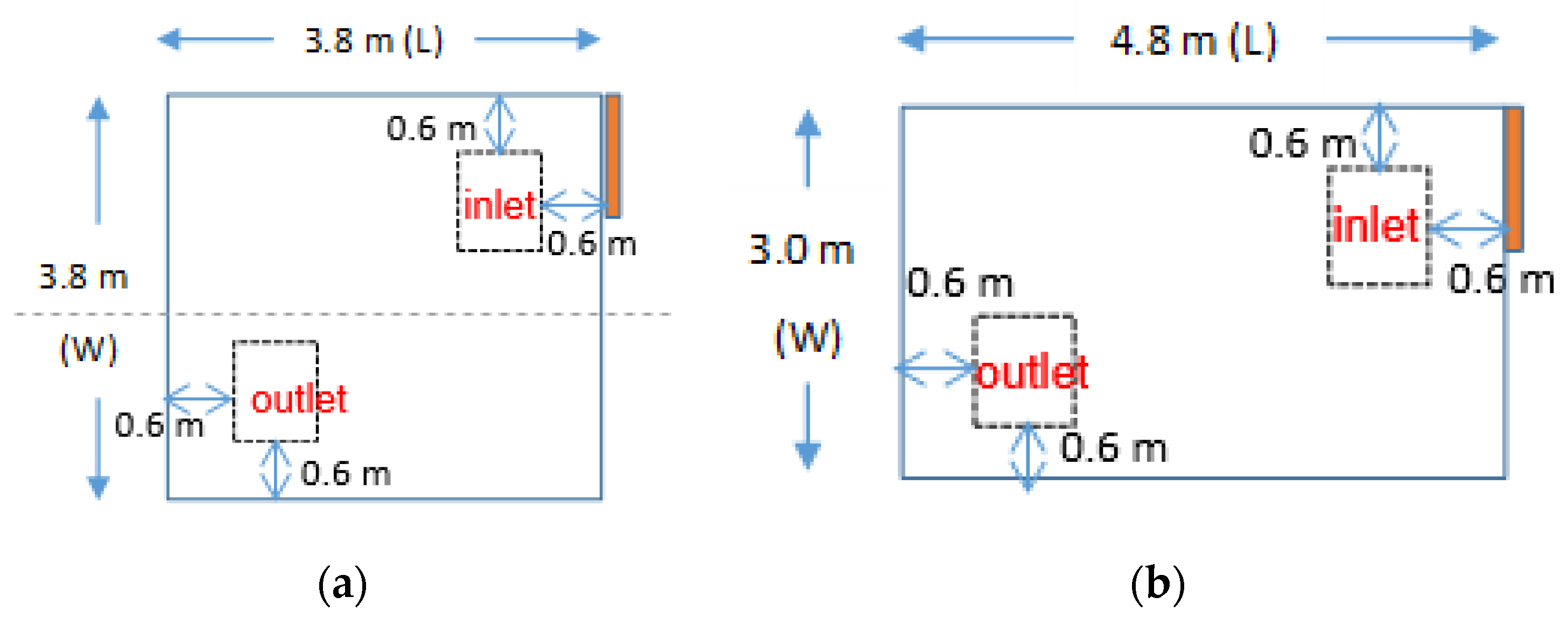

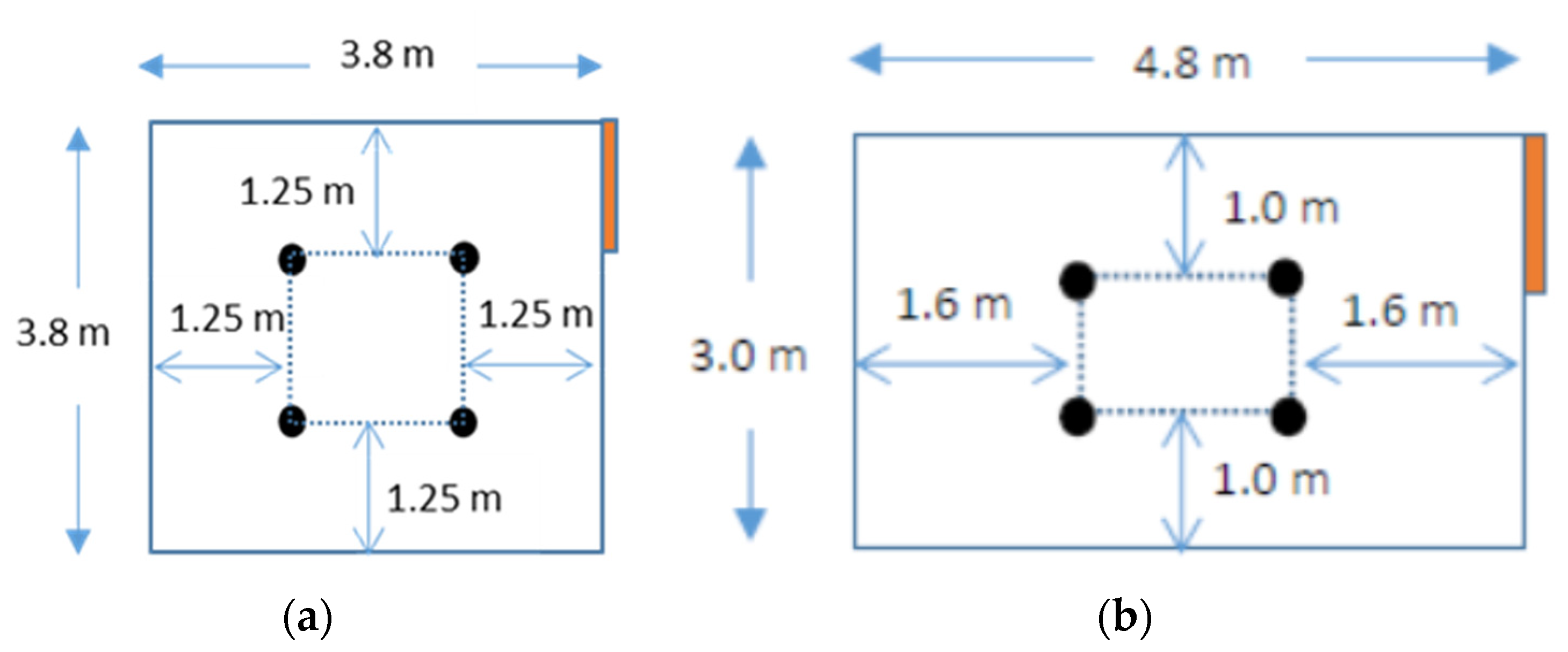


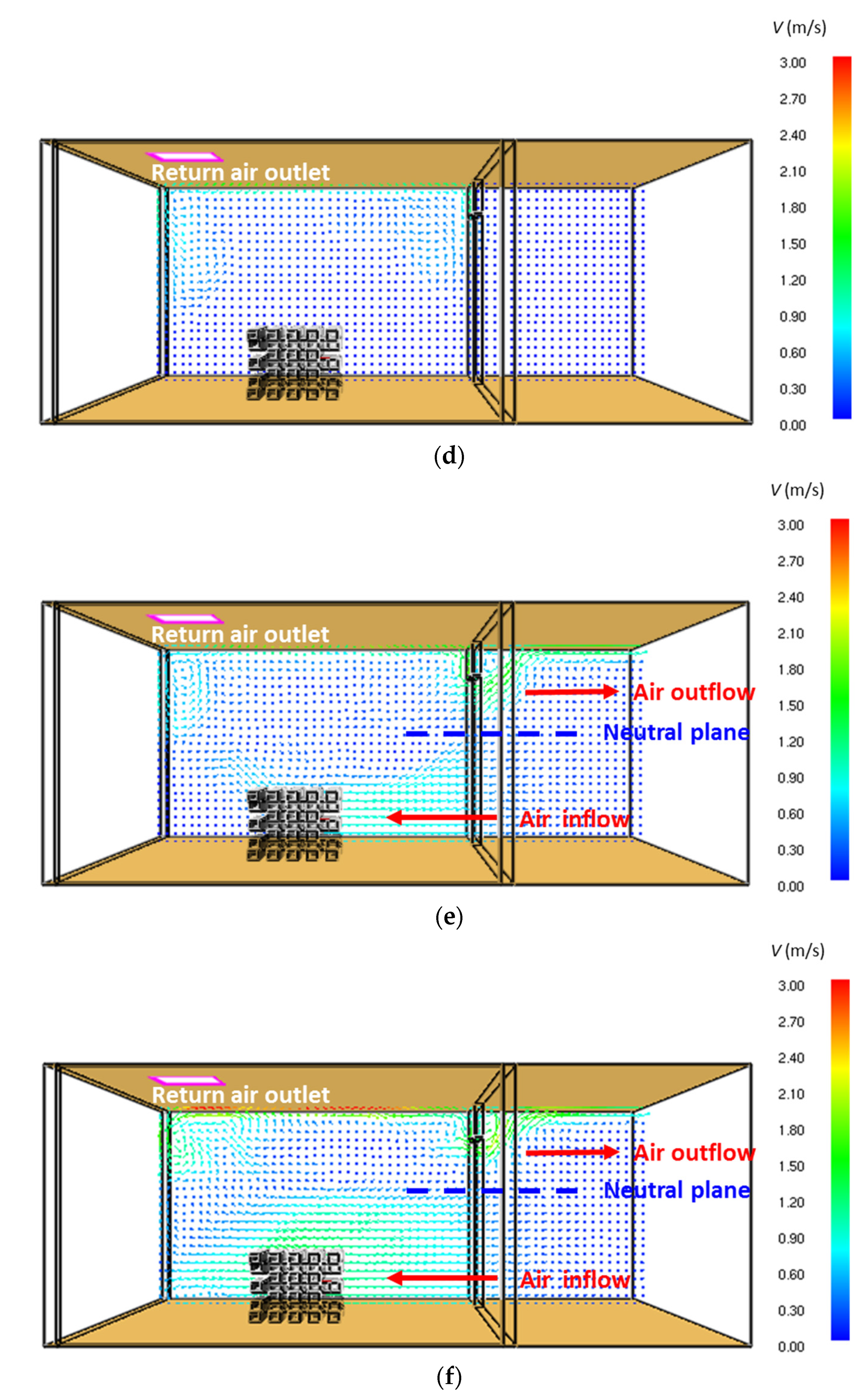
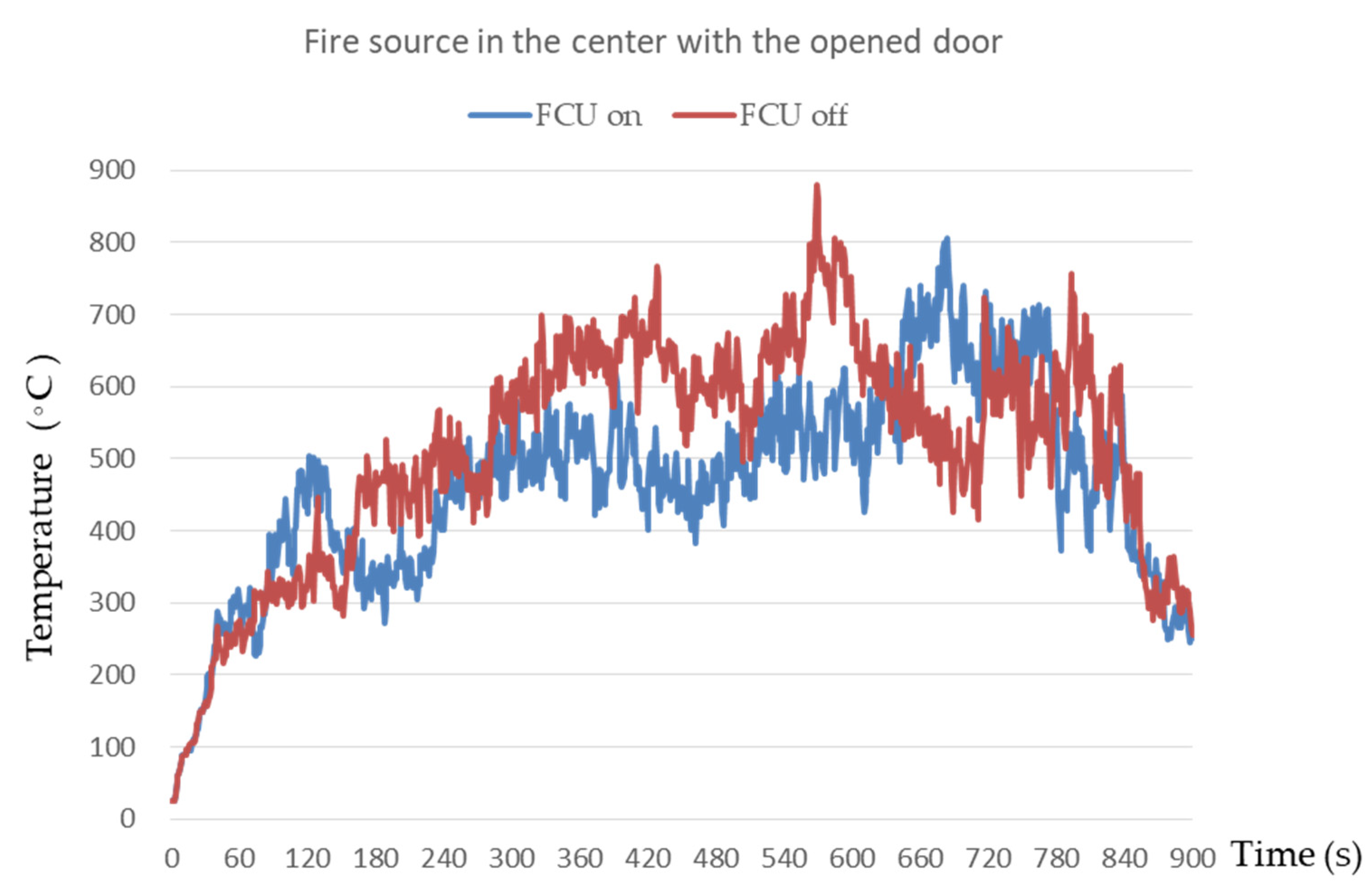
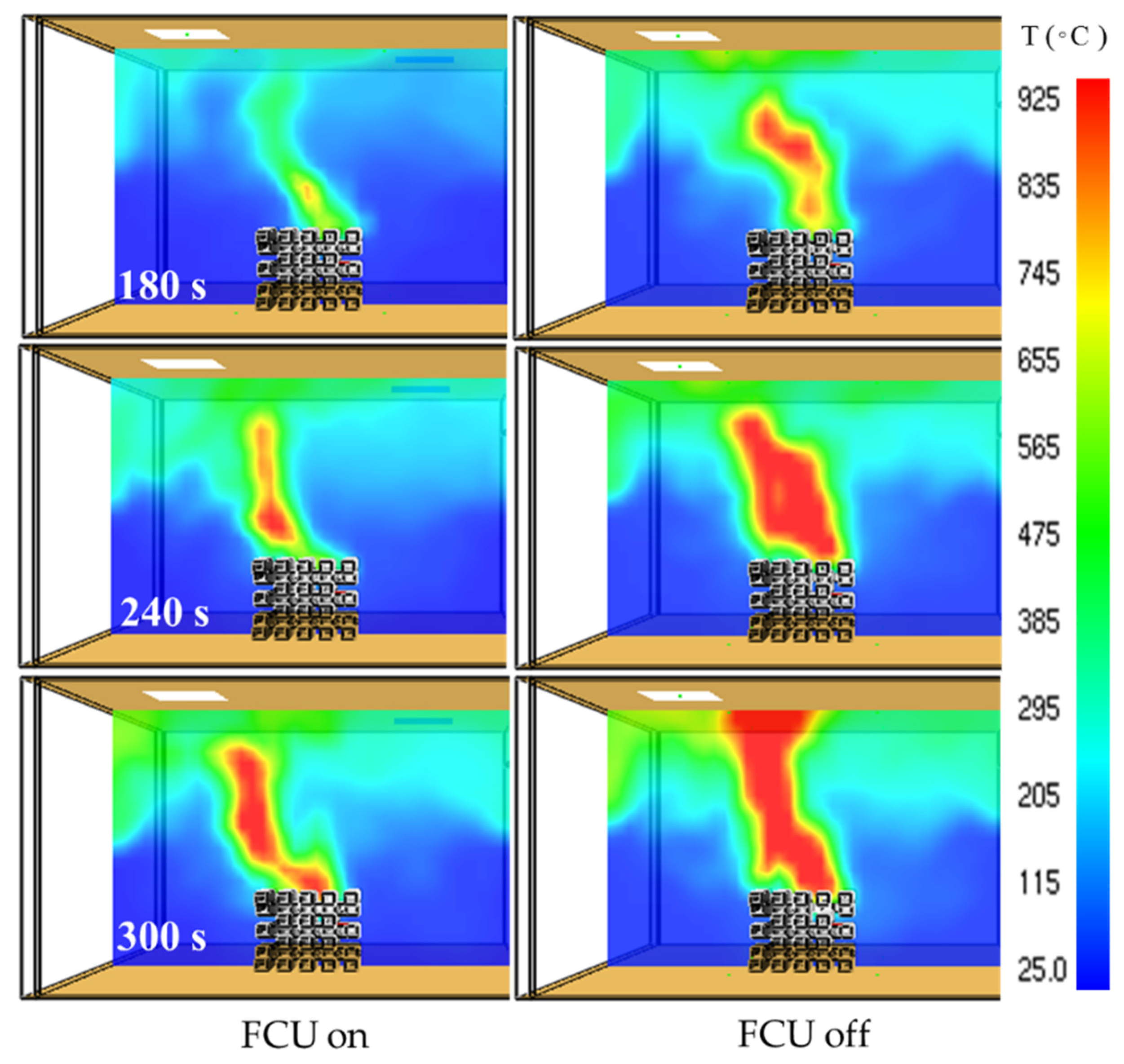


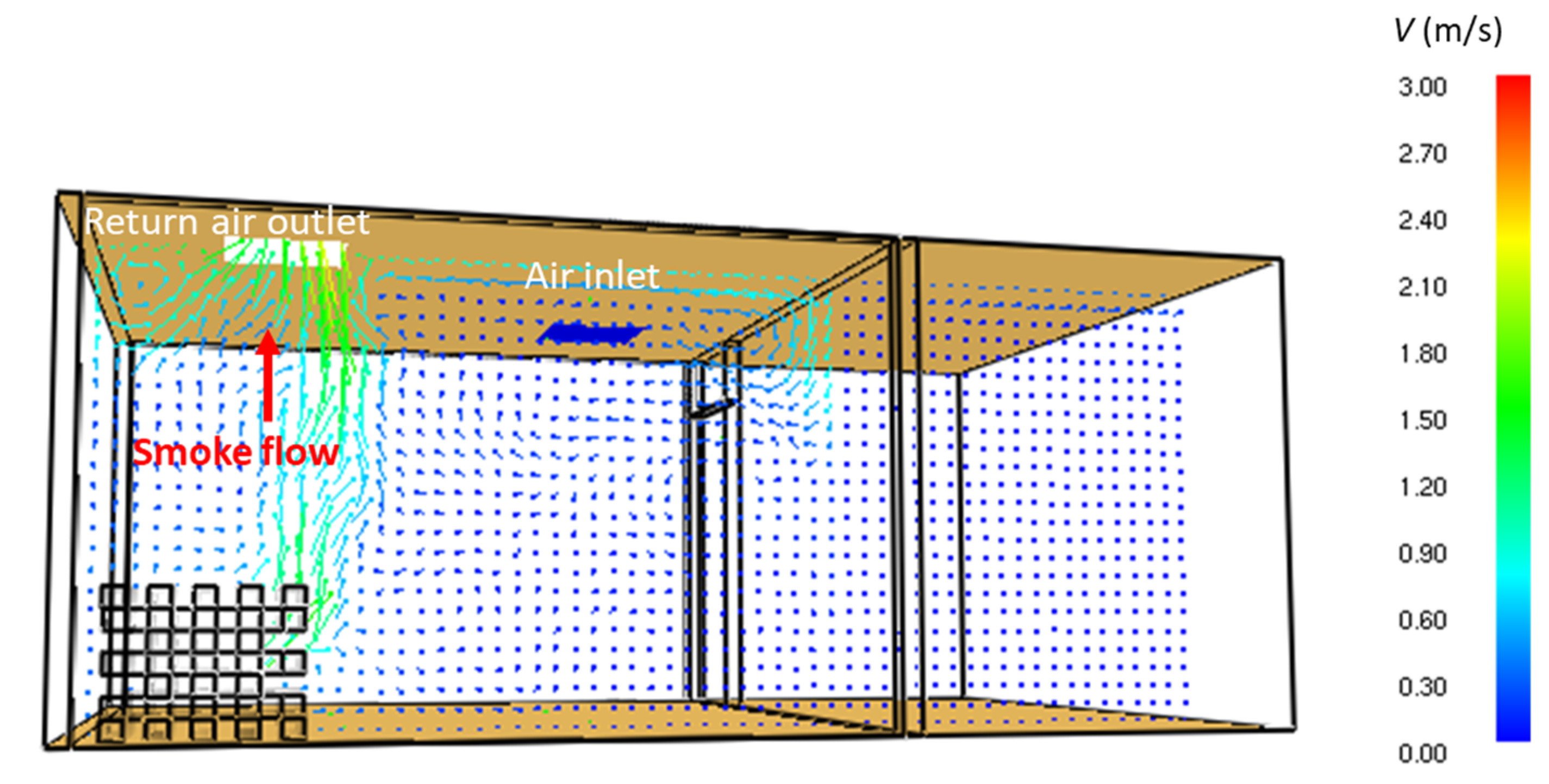
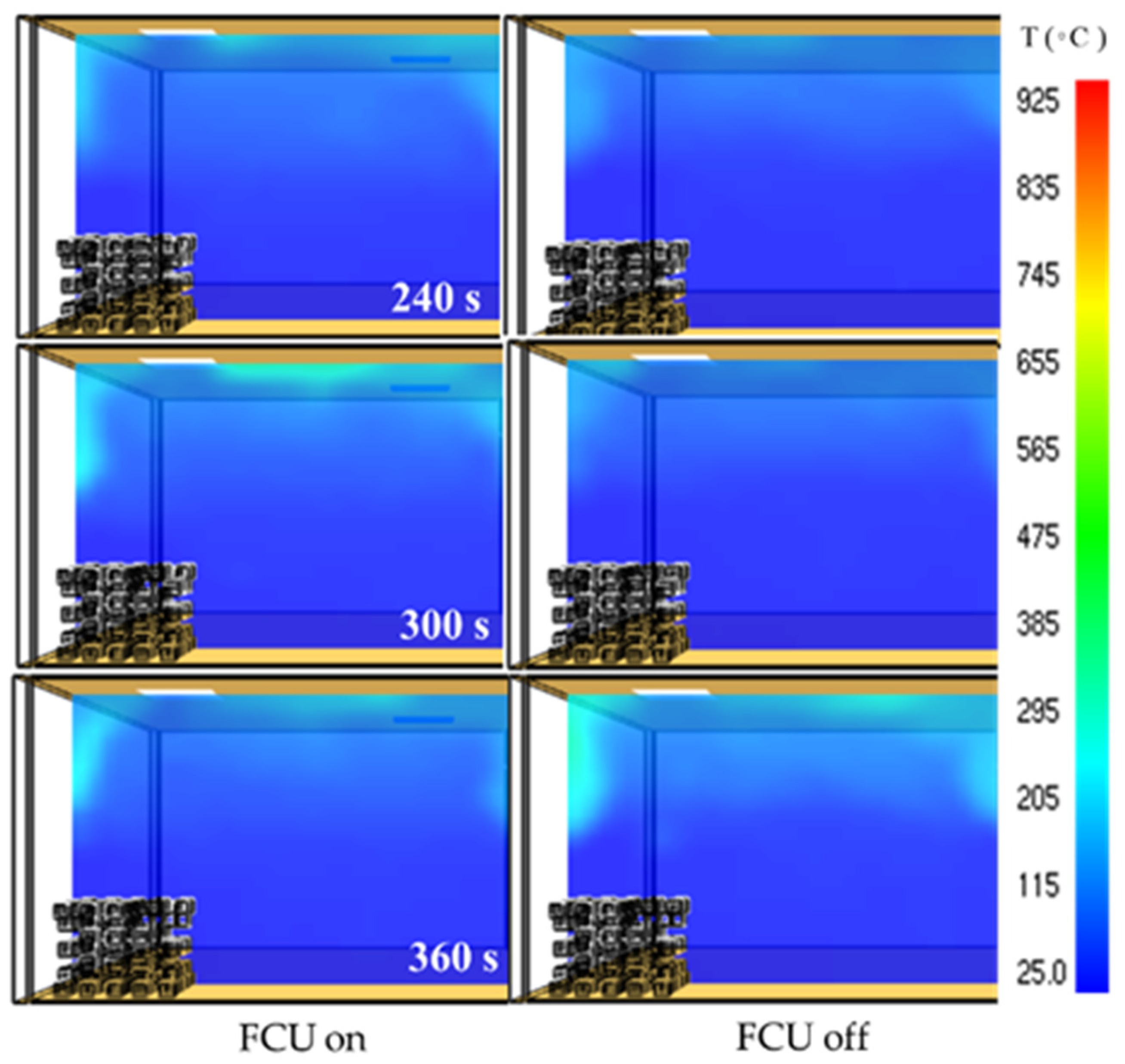

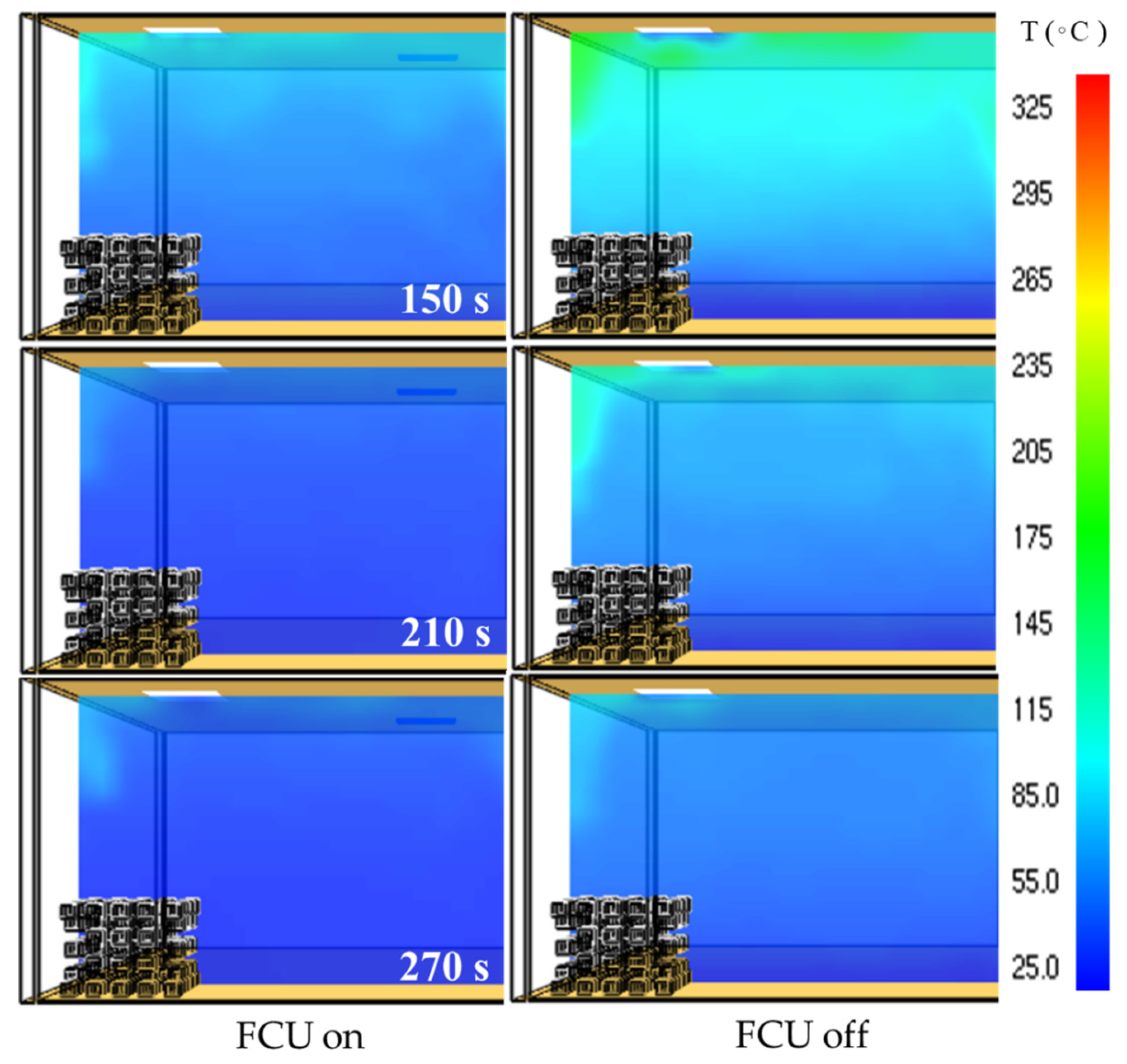
| Scholar | Room Size L (m) × W (m) × H (m) | Ventilation | |
|---|---|---|---|
| Natural (Door or Window) | Mechanical (Fans or Blowers) | ||
| Pretrel and Such [13] | 9 × 5.7 × 7.5 | ˇ | |
| Song et al. [18] | 0.8 × 0.8 × 0.8 | ˇ | |
| Parkes and Fleischmann [19] | 3.6 × 2.4 × 1.2 | ˇ | |
| Saber and Kashef [20] | 4.2 × 3.8 × 2.4 | ˇ | |
| Saber and Kashef [21] | 4.2 × 3.8 × 2.4 | ˇ | |
| Merci and Vandevelde [22] | 3 × 3.6 × 2.3 | ˇ | |
| Merci and Maele [23] | 3 × 3.6 × 2.3 | ˇ | |
| Lassus et al. [24] | 2 × 2 × 2 | ˇ | |
| Gomez et al. [25] | 32 × 17 × 8 | ˇ | ˇ |
| Thomas and Bennetts [26] | 1.5 × 0.6 × 0.3 | ˇ | |
| Pierce and Moss [27] | 1.8 × 1.2 × 1.2 | ˇ | |
| Tofilo et al. [28] | 1.2 × 0.8 × 0.8 | ˇ | |
| Kumar and Naveen [29] | 2.79 × 2.24 × 1.62 | ˇ | |
| Huang et al. [30] | 22.5 × 16 × 12 | ˇ | |
| Su et al. [31] | 2.3 ×1.3 × 2.5 | ˇ | ˇ |
| Wang and Tsai [32] | 3.8 × 3.8 × 2.4 | ˇ | ˇ |
Publisher’s Note: MDPI stays neutral with regard to jurisdictional claims in published maps and institutional affiliations. |
© 2021 by the authors. Licensee MDPI, Basel, Switzerland. This article is an open access article distributed under the terms and conditions of the Creative Commons Attribution (CC BY) license (https://creativecommons.org/licenses/by/4.0/).
Share and Cite
Wang, T.-Y.; Tsai, K.-C. Effects of Time to Unactuate Air Conditioning on Fire Growth. Energies 2021, 14, 3100. https://doi.org/10.3390/en14113100
Wang T-Y, Tsai K-C. Effects of Time to Unactuate Air Conditioning on Fire Growth. Energies. 2021; 14(11):3100. https://doi.org/10.3390/en14113100
Chicago/Turabian StyleWang, Teng-Yi, and Kuang-Chung Tsai. 2021. "Effects of Time to Unactuate Air Conditioning on Fire Growth" Energies 14, no. 11: 3100. https://doi.org/10.3390/en14113100






